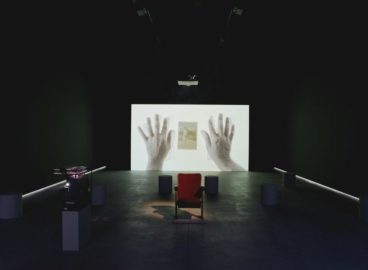MoMA’s C-MAP research program developed an extended focus on historical alliances such as Bandung, the Non-Aligned Movement (NAM), pan-Africanism, pan-Arabism, and other south-south, east-east, and Third World nexuses. This focus has been part of a broader effort to consider methodological approaches that don’t simply insert hitherto unacknowledged protagonists, events, and artworks into a global or Western hegemonic history. Many of Naeem Mohaiemen’s works since 2006, featured at MoMA PS1 in the exhibition There Is No Last Man, have engaged these international histories and legacies. This conversation addresses such pasts, and their reverberations in the present, as they appear in Mohaiemen’s media-based practice.

Sarah Lookofsky: Let’s begin with your exhibition at MoMA PS1 consisting of the diptych series Volume Eleven (flaw in the algorithm of cosmopolitanism) (2016) and the film Tripoli Cancelled (2017), which premiered at documenta 14 in Athens. Both works revolve around a singular character’s narrative in ways that blur fictional accounts and pivotal historical events. Volume Eleven addresses the writings of your great-uncle Syed Mujtaba Ali (1904–1974), particularly his 1930s essays in which he misrecognizes the German army as a potential liberator of India from British colonial rule. Tripoli Cancelled is a fictional departure from your father’s involuntary stay at Ellinikon International Airport after losing his passport in transit, however, in the film, it’s unclear where and when the story is taking place and who this personage is. Can you talk a bit about the deliberate slippages in the narratives of these works, which are then transferred to viewers as they try to “situate” them?
Naeem Mohaiemen: These slippages you refer to begin from the language the characters speak, and then they move into the crisscrossing of events from different times. When we were planning the MoMA PS1 show, there were conversations with Peter Eleey about the “Muselmann” chapter in the philosopher Giorgio Agamben’s Remnants of Auschwitz. Muselmann is an antiquated German word for Muslim, and was used at Auschwitz for prisoners who were too weak to survive and had given up hope. This use was documented in the Holocaust memoirs of Primo Levi and Adolf Gawalewicz, among others (the latter I tracked down through documenta 14 artistic director Adam Szymczyk, who had a copy of the Polish original). It was presumed to be a reference to the stooped posture of starving prisoners, which was supposedly “similar” to the Muslim form of prayer. Agamben gives a complex redefinition, suggesting that this word could signify “submission” to god. I am unconvinced that this was the origin of the term, but that needs a much longer discussion.
This “Muselmann” figure shows up in the film’s protagonist’s letter to his wife on the runway, and then in the bar scene, when he refuses a whisky, explaining, “I’m a Muselmann.” The phantom bartender replies, “Ah yes, we had a Muselmann here before. He was leaving Germany.” The “leaving Germany” reference is to the Muslim Germans (tiny in number), who may also have been persecuted by the Nazis but aren’t noted in historical accounts.

So Tripoli Cancelled contains “Der Muselmann” as an end state in Auschwitz, and “a Muselmann” as an escapee from Germany. The unnamed protagonist refers to a dinner guest, meant to be Hannah Arendt, reporting from the Jerusalem trial and infuriating readers with the “Banality of Evil” thesis. In the back room of the PS1 show, in Volume Eleven, my great-uncle asks of Arendt, “Write alongside me / this banality we ignored / century’s witness.” His posthumous mea culpa says: I was wrong, but so were many others.
None of these events are contemporaneous, and that is the other slippage in the work: my great-uncle’s essays were written in the early 1930s, and Arendt’s book on Adolf Eichmann came out thirty years later, in 1963. They could never have written “alongside”—he had returned to Asia; his European time was over. A Muslim author, from [British] India, with a German lover—this is a trifecta of conditions that would not make it easy for him to recover from the error of supporting the German army. Putting the time out of joint in my work was one way of giving Mujtaba Ali a chance of a fair(er) hearing.

Lookofsky: And what to make of the repeated reference to the Holocaust across several of your works? For Agamben, it is the paradigmatic modern event, requiring for its execution a modern state apparatus. The foregrounding of 1945 as a global marker has been contested by some as yet more Eurocentrism (massive killings wrought by colonialism and 1947’s Partition of the subcontinent are also pivotal modern events, for example). These two works of yours speak not to the events themselves, but perhaps instead to their reverberations.
Mohaiemen: I have for a long time been invested in burrowing into the Holocaust’s centrality to a European concept of “zero hour”—this also shows up in my earlier video Der Weisse Engel (2011). The camps loom large in Tripoli Cancelled, and later so do the trials in the reference to Arendt. And then a fatal misreading of the German genocide project in Mujtaba Ali’s essays, which is the reveal of Volume Eleven, in the back room. An idea of modernity hitting a reset, a “never seen before” brutality. In actuality, colonial praxis had already refined this template of subjugation, domination, and annihilation. The system shock of the Holocaust is the boomeranging of these same tactics onto the European body. Human history has been a replay of this breakdown—a willed blindness to genocidal tactics, whether carried out by neighbor or state, as long as they target an accepted subject of dominion, framed by holy doctrine or racialized capitalism. The Holocaust, and the debates around the parameters of its inscribing (Daniel Jonah Goldhagen’s ordinary Germans, Harun Farocki’s aerial blindness, or Giorgio Agamben’s Muselmann), open up ways to look at other instances of human history from within even this over-familiar, presumably “Eurocentric” space.

Lookofsky: I’d like to segue to your three-channel film Two Meetings and a Funeral, which premiered at documenta 14 in Kassel in 2017, and which specifically addressed the Non-Aligned Movement (NAM), a topic we have engaged in through our research at MoMA. The titular two meetings refer to two transnational summits in the early history of Bangladesh, since it achieved independence in 1971 following a civil war with Pakistan. The first is the fourth summit of NAM in Algeria in 1973. In this context, Bangladesh was allied with India, one of the founding members of the organization, and loyal to the project of finding a socialist alternative to the Soviet model. The second meeting that brackets the story is the conference of the Organization of the Islamic Cooperation (OIC) held in Pakistan a year later, in 1974. As the film’s intertitles invoke, participation in this second meeting marked a shift from socialist aspirations to a new Islamic alignment shaped by the geopolitical oil bloc, which prevails in a weaker form to this day.
There is a prevailing sense of failure, loss, and even mourning in Two Meetings, and in other of your works that address transnational left networks. Of course, as your work teases out, these words have different implications, also alluding to the fact that some projects failed due to external imperial intervention, while others were perhaps ill conceived or doomed by internal power struggles. The contemporary protagonists of your film all display different degrees of what I would characterize as melancholy. I wonder, from your own perspective, if you think that there are elements of the original aspirations that are not completely lost in the present. Other works of yours have deliberately addressed left nostalgia, but I wonder how you would diagnose your own relationship to these histories.

Mohaiemen: I didn’t set out to write a history of failure, left or otherwise. That would be an enervating way to spend eleven years, knowing that that is what it is going to be at the outset. When I started the overall project The Young Man Was in 2006, I had several problems I was trying to work through. The one that dominated was what I call the “accidental trojan horse”—an equation where an insurrectionary left political force, if it fails to seize power, ends up ushering in an even more rightist force than that which it was trying to unseat. It’s not ever (I hope) a left project to provide an alibi or channel for rightist forces, and that’s why it is “accidental.” Misrecognition—of staging ground, historic situation, vulnerabilities, and allies—could produce an end result that is anti- or misplaced solidarity, with catastrophic results. Over time, as my project kept collecting stories, failure as a result, and the memory of failure as an affective condition—with all the rivulets of melancholy, nostalgia, and regret—came out very sharply.
But consider the experience of Peter Custers, protagonist of Last Man in Dhaka Central [premiered at MoMA’s Doc Fortnight in 2016]. Inspired by Herbert Marcuse’s One-Dimensional Man, Peter drops out of his PhD program at Johns Hopkins University and moves to Asia in search of a “revolutionary proletariat.” When things go wrong, he is arrested along with members of an underground group, tortured, and only released because of the intervention of the Dutch parliament. Does he remember the time in jail in 1975 to be failure? The song at the beginning of that film is a famous Lucky Akhand one from my teenage years—not Peter’s early 1970s, but rather my late 1980s. It’s a song in the line of “you broke my heart and one day I will make you cry,” a story of vengeful and soured love. I wanted to use it to think through the modes of forgetting, betrayal, and leaving behind that are embedded in Peter’s survival while his comrades died in jail. Peter and I debated my choice of this song—one of many debates we had while making this film. He wanted to hold on to the story of the 1970s as something very different from how we talk of it now. He had not surrendered his story to the audience; he had not whispered, “Do as you will.” And in that fierce insistence that the survivor retains the right to the tone of the story is the refusal of this framing of loss or failure. I think, generationally, there’s a sharp and enduring struggle over how to remember the left project of the 1970s—as the survivors themselves wish to tell it, or how those of us who never lived it see it in the aftermath of now.

Lookofsky: Vijay Prashad—author of The Darker Nations, a key history of Third World movements—poignantly notes that he sees no visual evidence of anti-colonialism in Oscar Niemeyer’s Algerian sports stadium, La Coupole. One question that kept coming up for us at MoMA over the course of our research was whether these networks that were principally political and economic, and which are certainly pertinent as historical models to think about, also had notable or valuable cultural and artistic impacts—or if their principal aesthetic was a gigantism that mimics imperial international styles. Have you come across visual/aesthetic translations of anti-colonialism, egalitarianism, etc., or artistic projects that grew out of these international connections, that you find of value today?
Mohaiemen: Two Meetings is a project partially obsessed with buildings as the remains of that day. Many of these structures were completed in the 1970s, at a moment when oil revenues had been dramatically increasing. Like many of the OPEC [Organization of the Petroleum Exporting Countries] countries that became rich in the 1970s, Algeria didn’t plan for a future where carbon resources would run out. Vijay is overwhelmed by the nonuse of the space of La Coupole. But there are other moments—some didn’t make it into the final film—when he is inspired by the sweeping architecture as well. The aesthetics of that moment aren’t automatically empty or wasteful. Many structures were designed in the flush of space exploration, intended to also evoke existence within the long durée of the universe.
Thinking of anti-colonial aesthetics that do resonate, I also want to shift from the buildings to the people who inhabited them. Dominique Malaquais of Institut des Mondes Africains in Paris presented a research project at the Returns conference in Chicago. It is a work on the gatherings of pan-African solidarity—four pan-African cultural festivals, including Festac ’77 in Lagos. Among the things I appreciated there were the commemorative impulse and the material culture around which that remembering can take place—akin to the tactile pleasure of celluloid. In these four festivals, the aesthetic of the individual participants is not grandstanding, but rather a joyful and confident proposal of an alter-modernity.
Lookofsky: One of the most striking features of the film is your contemporary movement through architectural spaces from this period. We see the now-empty buildings as shells that sharply contrast with the bustling action in the archival documentation of the meetings that were once held there.
Mohaiemen: The Palais des Nation in Algiers was a vacuum space and, for us, a sentimental space as well. It is sometimes used for conferences, but that wasn’t the case when we were there. The venue has a team of people who clean every day. We have some of that on camera, where they’re sweeping the floors and changing the tablecloths—even though there’s no dinner happening, as if a grand dinner is always about to happen.
Lookofsky: For me, one effect of the film’s back-and-forth between past and present is that both periods become destabilized: received truths about the past are unmoored and the certainty and fixity of the present, and its power distributions, might be too. On another level, the film also dwells on the temporality of these conferences, which appear very long and thus dominated by inattention, small talk, distraction, even boredom. Why did you decide to focus on these records of the talks?

Mohaiemen: The exhaustive record, iteratively viewed, can suddenly produce unexpected moments of insight. Certain speeches and personas are more visually provocative—they are what we’re drawn to, but not where the actual work is happening. The real event is the backroom meeting, where there is no camera rolling. The conversations over endless coffees and cigarettes were where decisions were made. In NAM, Bandung’s Afro-Asian unity proposal is no longer dominant. Those who were wary of Soviet expansionism wanted to have their own zone of influence—NAM was also a power bloc, and it was never innocent of those maneuvers. Since there was still a socialist commitment, there should have been class alliances that span all member nations. But NAM also included the OPEC bloc countries, which were not always signaling to socialism—so they’re an uneasy fit. These contradictions come spilling out in the small, offstage visual moments of the conference.
In one newsreel, you see Kenneth Kaunda of Zambia saying onstage, “We wish our brother, Salvador Allende, to prevail,” and then we learn that Allende was assassinated four days later. NAM appears to be, in that scene, opposed to military juntas. Yet, when the impassive camera pans, there are other Latin American leaders attending in full military gear! So NAM fails to take up a position that welcomes only democratic countries. This is a contradiction that jumps out in the long, slow visual record of the meetings. It is not so much what is onstage, but what gets picked up as the camera roves and happens upon chance encounters in a cavernous meeting hall. During the extended credit sequence, if you watch closely, you start to notice who gets up from their table to greet which leader. Also, who stands up first, and who stays seated—these are all part of the archaeology, a way to map the bodily expressions of hierarchy and power.
Lookofsky: The film powerfully opens with a comment by the then–minister of foreign affairs of Singapore, Sinnathamby Rajaratnam, in which he addresses a technical breakdown of the communication system at the NAM conference, noting that the equipment used to threaten imperial powers is built by them; “They turn it off, we are lost.” This is of course a potent and brutal metaphor about the very possibility, even futility, of creating alternative power networks in a world in which the infrastructure of power and wealth is so unequally distributed. Could you unpack a bit your use and interpretation of Rajaratnam’s metaphor?
Mohaiemen: What was the common project of NAM? It was “outside of alignment” with great powers, but it was supposed to be much more. Rajaratnam says “the old cold power” is over—because the Algiers meeting is taking place after the signing by the US and Soviets of the first SALT (Strategic Arms Limitation Talks) treaty. Essentially, he is asking, now that one of our primary rationales for being together is removed, what is the need for nonalignment. (Of course the Cold War revives it, but in 1973 he could not yet see that.)
Singapore is largely ignored in that NAM summit, because the way he frames the question is not quite welcome. He frames it as a question of technology autonomy, of trading blocs, of shared industrialization. This type of focus on trade-driven growth, minus Soviet, OPEC, or other subsidies, was an unwelcome formulation within the socialist-leaning rubric of NAM. But this association with socialism is also ambivalent and contradictory. Oil wealth, Cold War–driven subsidies, and imported labor underwrote some of the rapid infrastructure development of the 1970s. The structural problems of socialism, including what kind of sustainable industrialization and trade policy you may have, remained unaddressed.
The fact that a large portion of the audience, including the charismatic liberators, all had their headphones off during Rajaratnam’s speech is a telltale sign they were not really listening to him. His warnings to evolve, and to control the means of technological production, went largely unheard. I am interested to sometimes imagine an alter-history—one where the writer Rajaratnam (who was mentored by George Orwell), rather than the charismatic guerrilla leader Fidel Castro, could have been the leader of that 1973 NAM summit. That is the history that did not come to pass—whether it would have delivered a version of socialism that could have survived, we will never know.





